Master's Research Project: ERA, Construction, and BIM
VerifiedAdded on 2022/12/28
|19
|6521
|1
Report
AI Summary
This Master's research project investigates environmental risk assessment (ERA) in the context of construction, particularly focusing on the redevelopment of contaminated sites. The study explores the integration of Building Information Modeling (BIM) and Conceptual Site Modeling (CSM) to address the challenges of brownfield development and promote sustainable practices. The research examines the gaps in knowledge between ERA and construction, assesses the role of BIM in developing digital CSMs for geology, hydrology, and hydrogeology, and identifies common parameters in both ERA and construction contexts. The methodology includes a literature review, survey questionnaires, and data analysis to determine the efficiency of the framework. The report highlights the significance of the research in enhancing communication between risk consultants and engineers, ultimately contributing to sustainable development and improved project performance. Recommendations are provided to further advance the project's performance levels.
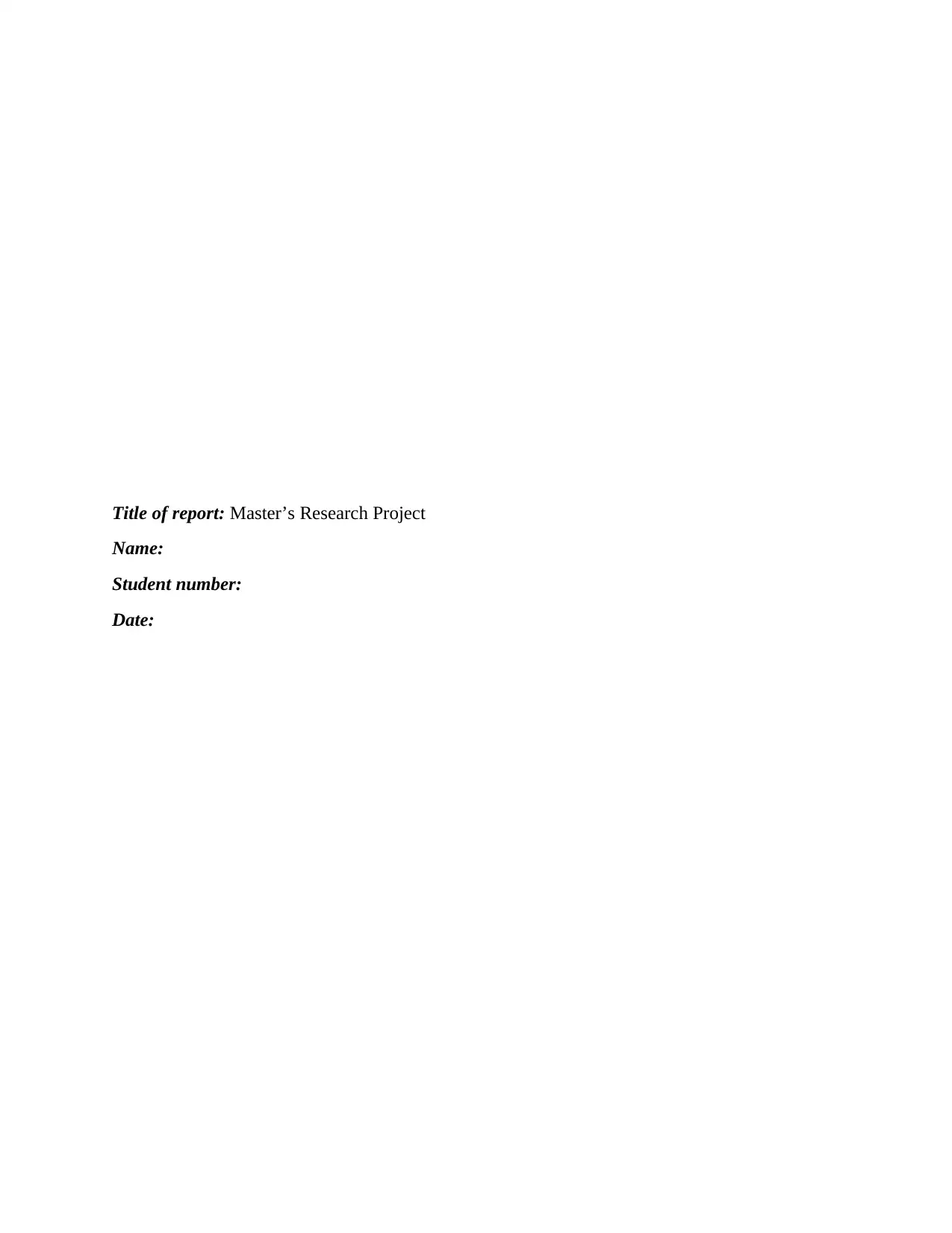
Title of report: Master’s Research Project
Name:
Student number:
Date:
Name:
Student number:
Date:
Paraphrase This Document
Need a fresh take? Get an instant paraphrase of this document with our AI Paraphraser
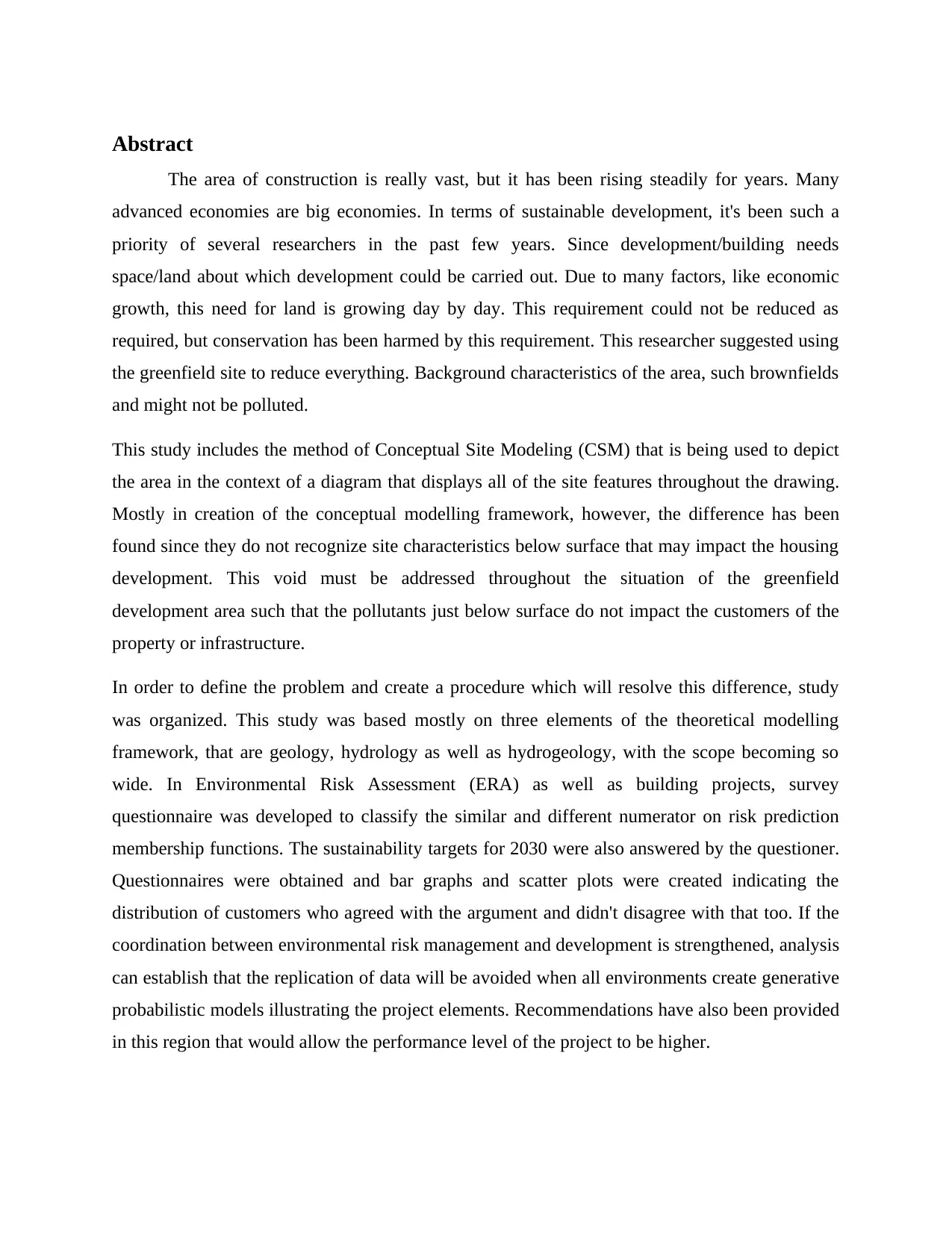
Abstract
The area of construction is really vast, but it has been rising steadily for years. Many
advanced economies are big economies. In terms of sustainable development, it's been such a
priority of several researchers in the past few years. Since development/building needs
space/land about which development could be carried out. Due to many factors, like economic
growth, this need for land is growing day by day. This requirement could not be reduced as
required, but conservation has been harmed by this requirement. This researcher suggested using
the greenfield site to reduce everything. Background characteristics of the area, such brownfields
and might not be polluted.
This study includes the method of Conceptual Site Modeling (CSM) that is being used to depict
the area in the context of a diagram that displays all of the site features throughout the drawing.
Mostly in creation of the conceptual modelling framework, however, the difference has been
found since they do not recognize site characteristics below surface that may impact the housing
development. This void must be addressed throughout the situation of the greenfield
development area such that the pollutants just below surface do not impact the customers of the
property or infrastructure.
In order to define the problem and create a procedure which will resolve this difference, study
was organized. This study was based mostly on three elements of the theoretical modelling
framework, that are geology, hydrology as well as hydrogeology, with the scope becoming so
wide. In Environmental Risk Assessment (ERA) as well as building projects, survey
questionnaire was developed to classify the similar and different numerator on risk prediction
membership functions. The sustainability targets for 2030 were also answered by the questioner.
Questionnaires were obtained and bar graphs and scatter plots were created indicating the
distribution of customers who agreed with the argument and didn't disagree with that too. If the
coordination between environmental risk management and development is strengthened, analysis
can establish that the replication of data will be avoided when all environments create generative
probabilistic models illustrating the project elements. Recommendations have also been provided
in this region that would allow the performance level of the project to be higher.
The area of construction is really vast, but it has been rising steadily for years. Many
advanced economies are big economies. In terms of sustainable development, it's been such a
priority of several researchers in the past few years. Since development/building needs
space/land about which development could be carried out. Due to many factors, like economic
growth, this need for land is growing day by day. This requirement could not be reduced as
required, but conservation has been harmed by this requirement. This researcher suggested using
the greenfield site to reduce everything. Background characteristics of the area, such brownfields
and might not be polluted.
This study includes the method of Conceptual Site Modeling (CSM) that is being used to depict
the area in the context of a diagram that displays all of the site features throughout the drawing.
Mostly in creation of the conceptual modelling framework, however, the difference has been
found since they do not recognize site characteristics below surface that may impact the housing
development. This void must be addressed throughout the situation of the greenfield
development area such that the pollutants just below surface do not impact the customers of the
property or infrastructure.
In order to define the problem and create a procedure which will resolve this difference, study
was organized. This study was based mostly on three elements of the theoretical modelling
framework, that are geology, hydrology as well as hydrogeology, with the scope becoming so
wide. In Environmental Risk Assessment (ERA) as well as building projects, survey
questionnaire was developed to classify the similar and different numerator on risk prediction
membership functions. The sustainability targets for 2030 were also answered by the questioner.
Questionnaires were obtained and bar graphs and scatter plots were created indicating the
distribution of customers who agreed with the argument and didn't disagree with that too. If the
coordination between environmental risk management and development is strengthened, analysis
can establish that the replication of data will be avoided when all environments create generative
probabilistic models illustrating the project elements. Recommendations have also been provided
in this region that would allow the performance level of the project to be higher.
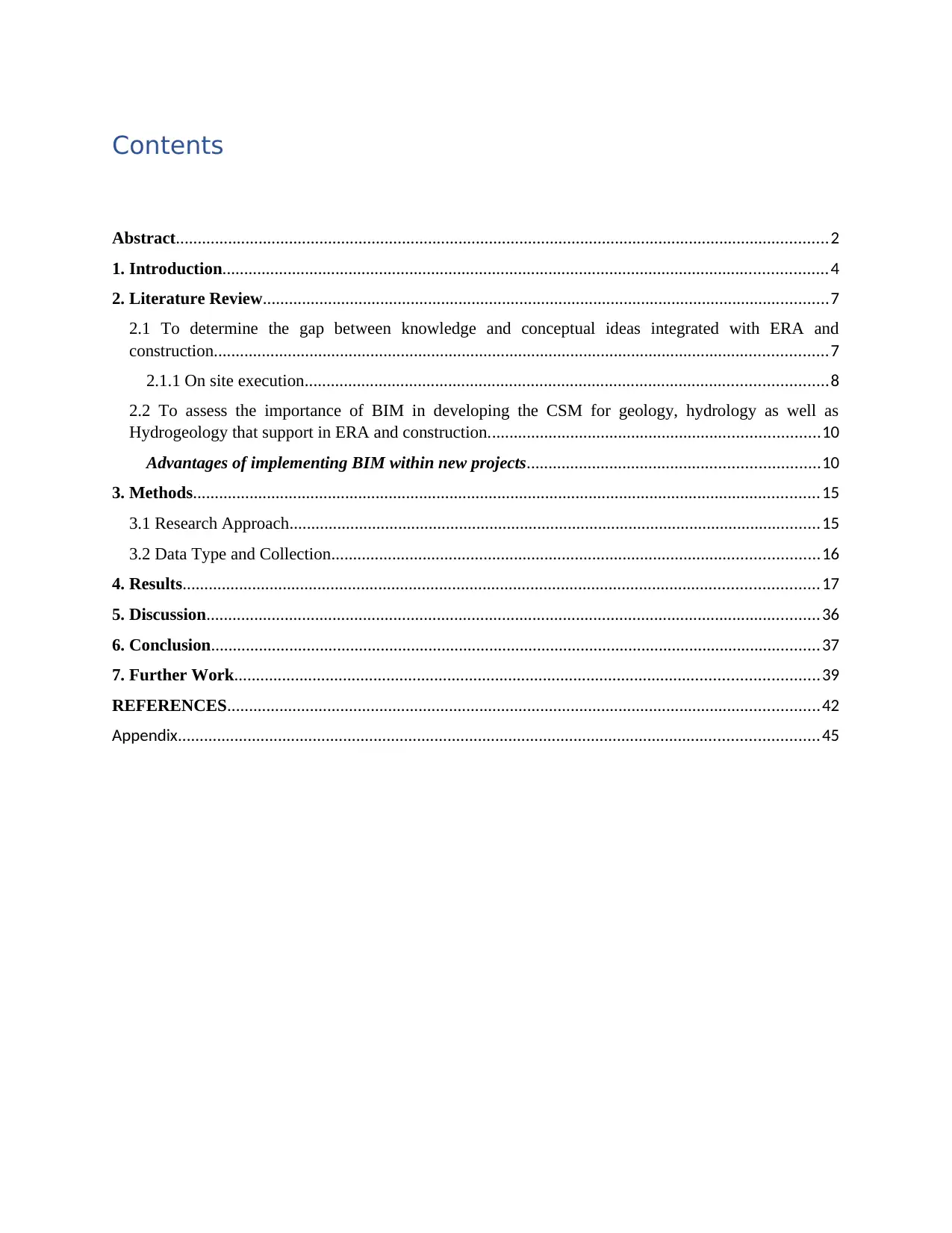
Contents
Abstract......................................................................................................................................................2
1. Introduction...........................................................................................................................................4
2. Literature Review..................................................................................................................................7
2.1 To determine the gap between knowledge and conceptual ideas integrated with ERA and
construction.............................................................................................................................................7
2.1.1 On site execution........................................................................................................................8
2.2 To assess the importance of BIM in developing the CSM for geology, hydrology as well as
Hydrogeology that support in ERA and construction............................................................................10
Advantages of implementing BIM within new projects...................................................................10
3. Methods................................................................................................................................................15
3.1 Research Approach..........................................................................................................................15
3.2 Data Type and Collection................................................................................................................16
4. Results..................................................................................................................................................17
5. Discussion.............................................................................................................................................36
6. Conclusion............................................................................................................................................37
7. Further Work......................................................................................................................................39
REFERENCES........................................................................................................................................42
Appendix...................................................................................................................................................45
Abstract......................................................................................................................................................2
1. Introduction...........................................................................................................................................4
2. Literature Review..................................................................................................................................7
2.1 To determine the gap between knowledge and conceptual ideas integrated with ERA and
construction.............................................................................................................................................7
2.1.1 On site execution........................................................................................................................8
2.2 To assess the importance of BIM in developing the CSM for geology, hydrology as well as
Hydrogeology that support in ERA and construction............................................................................10
Advantages of implementing BIM within new projects...................................................................10
3. Methods................................................................................................................................................15
3.1 Research Approach..........................................................................................................................15
3.2 Data Type and Collection................................................................................................................16
4. Results..................................................................................................................................................17
5. Discussion.............................................................................................................................................36
6. Conclusion............................................................................................................................................37
7. Further Work......................................................................................................................................39
REFERENCES........................................................................................................................................42
Appendix...................................................................................................................................................45
⊘ This is a preview!⊘
Do you want full access?
Subscribe today to unlock all pages.

Trusted by 1+ million students worldwide

1. Introduction
Background
The need for development has increased as a result of urbanization and an increase in the overall
living standards of people (Abdullahi and Pradhan, 2016). In context to urban planning,
brownfields can be defined as a previously developed land that is not in use currently that is
potentially contaminated. The land might have been in use for either commercial or industrial
purposes. The contamination at a brownfield can be related to soil as many hazardous wastes are
emitted during the manufacture of products. But with the constant increase in the urbanization,
the availability of land has become restricted. Therefore, brownfields can be utilized as this will
also help in preserving the green lands. Since the brownfields are contaminated from different
types of waste, it is important to undertake a risk assessment. This is important because it will
help in identifying and assessing the different risks that can affect the overall project.
Problem statement
Unavailability of land is one of the principal issues that comes up during the construction
of buildings. Also, when a building has to be constructed on a brownfield, there can also be
certain environment risks that can come up as the site is contaminated. Building Information
Modelling or BIM can be defined as a 3D model which is a process that gives engineering,
construction as well as architecture professionals, useful insights so that they can plan
effectively. ERA or Environmental Risk Assessment is a process that helps in identifying as well
as evaluating the likelihood of a business to threaten the environment. An environmental danger
evaluation lets the researcher to evaluate the chance of your business causing harm to the
surroundings. This consists of describing capacity risks and affects earlier than taking
precautions to lessen the risks. This is particularly related to living organisms, ecosystems as
well as natural habitats. The respective report is focused on the redevelopment of abandoned
assets. There is also a discussion about the different challenges that can come up to approach
environmental management as well as planning (Abebe, Kabir and Tesfamariam, 2018). In
present time, the concept of aiding computer modelling related to conceptual site models while
doing construction is not large as compared to ERA. Thus through this research it will be
recommended to the construction firm to make more use of CSM that will ease the work of
engineers in order to complete the design of already prepared structure in an effective manner.
Background
The need for development has increased as a result of urbanization and an increase in the overall
living standards of people (Abdullahi and Pradhan, 2016). In context to urban planning,
brownfields can be defined as a previously developed land that is not in use currently that is
potentially contaminated. The land might have been in use for either commercial or industrial
purposes. The contamination at a brownfield can be related to soil as many hazardous wastes are
emitted during the manufacture of products. But with the constant increase in the urbanization,
the availability of land has become restricted. Therefore, brownfields can be utilized as this will
also help in preserving the green lands. Since the brownfields are contaminated from different
types of waste, it is important to undertake a risk assessment. This is important because it will
help in identifying and assessing the different risks that can affect the overall project.
Problem statement
Unavailability of land is one of the principal issues that comes up during the construction
of buildings. Also, when a building has to be constructed on a brownfield, there can also be
certain environment risks that can come up as the site is contaminated. Building Information
Modelling or BIM can be defined as a 3D model which is a process that gives engineering,
construction as well as architecture professionals, useful insights so that they can plan
effectively. ERA or Environmental Risk Assessment is a process that helps in identifying as well
as evaluating the likelihood of a business to threaten the environment. An environmental danger
evaluation lets the researcher to evaluate the chance of your business causing harm to the
surroundings. This consists of describing capacity risks and affects earlier than taking
precautions to lessen the risks. This is particularly related to living organisms, ecosystems as
well as natural habitats. The respective report is focused on the redevelopment of abandoned
assets. There is also a discussion about the different challenges that can come up to approach
environmental management as well as planning (Abebe, Kabir and Tesfamariam, 2018). In
present time, the concept of aiding computer modelling related to conceptual site models while
doing construction is not large as compared to ERA. Thus through this research it will be
recommended to the construction firm to make more use of CSM that will ease the work of
engineers in order to complete the design of already prepared structure in an effective manner.
Paraphrase This Document
Need a fresh take? Get an instant paraphrase of this document with our AI Paraphraser
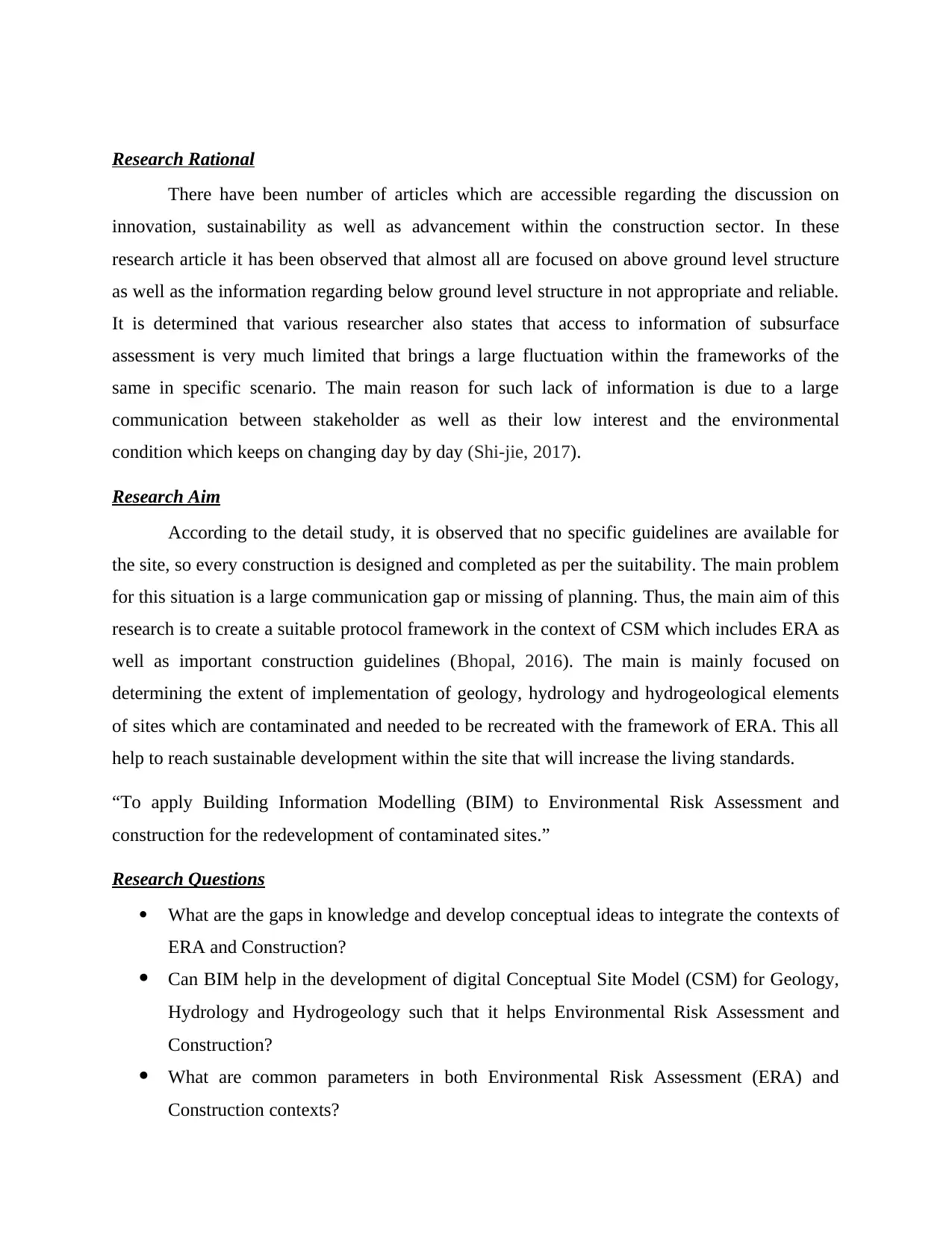
Research Rational
There have been number of articles which are accessible regarding the discussion on
innovation, sustainability as well as advancement within the construction sector. In these
research article it has been observed that almost all are focused on above ground level structure
as well as the information regarding below ground level structure in not appropriate and reliable.
It is determined that various researcher also states that access to information of subsurface
assessment is very much limited that brings a large fluctuation within the frameworks of the
same in specific scenario. The main reason for such lack of information is due to a large
communication between stakeholder as well as their low interest and the environmental
condition which keeps on changing day by day (Shi-jie, 2017).
Research Aim
According to the detail study, it is observed that no specific guidelines are available for
the site, so every construction is designed and completed as per the suitability. The main problem
for this situation is a large communication gap or missing of planning. Thus, the main aim of this
research is to create a suitable protocol framework in the context of CSM which includes ERA as
well as important construction guidelines (Bhopal, 2016). The main is mainly focused on
determining the extent of implementation of geology, hydrology and hydrogeological elements
of sites which are contaminated and needed to be recreated with the framework of ERA. This all
help to reach sustainable development within the site that will increase the living standards.
“To apply Building Information Modelling (BIM) to Environmental Risk Assessment and
construction for the redevelopment of contaminated sites.”
Research Questions
What are the gaps in knowledge and develop conceptual ideas to integrate the contexts of
ERA and Construction?
Can BIM help in the development of digital Conceptual Site Model (CSM) for Geology,
Hydrology and Hydrogeology such that it helps Environmental Risk Assessment and
Construction?
What are common parameters in both Environmental Risk Assessment (ERA) and
Construction contexts?
There have been number of articles which are accessible regarding the discussion on
innovation, sustainability as well as advancement within the construction sector. In these
research article it has been observed that almost all are focused on above ground level structure
as well as the information regarding below ground level structure in not appropriate and reliable.
It is determined that various researcher also states that access to information of subsurface
assessment is very much limited that brings a large fluctuation within the frameworks of the
same in specific scenario. The main reason for such lack of information is due to a large
communication between stakeholder as well as their low interest and the environmental
condition which keeps on changing day by day (Shi-jie, 2017).
Research Aim
According to the detail study, it is observed that no specific guidelines are available for
the site, so every construction is designed and completed as per the suitability. The main problem
for this situation is a large communication gap or missing of planning. Thus, the main aim of this
research is to create a suitable protocol framework in the context of CSM which includes ERA as
well as important construction guidelines (Bhopal, 2016). The main is mainly focused on
determining the extent of implementation of geology, hydrology and hydrogeological elements
of sites which are contaminated and needed to be recreated with the framework of ERA. This all
help to reach sustainable development within the site that will increase the living standards.
“To apply Building Information Modelling (BIM) to Environmental Risk Assessment and
construction for the redevelopment of contaminated sites.”
Research Questions
What are the gaps in knowledge and develop conceptual ideas to integrate the contexts of
ERA and Construction?
Can BIM help in the development of digital Conceptual Site Model (CSM) for Geology,
Hydrology and Hydrogeology such that it helps Environmental Risk Assessment and
Construction?
What are common parameters in both Environmental Risk Assessment (ERA) and
Construction contexts?
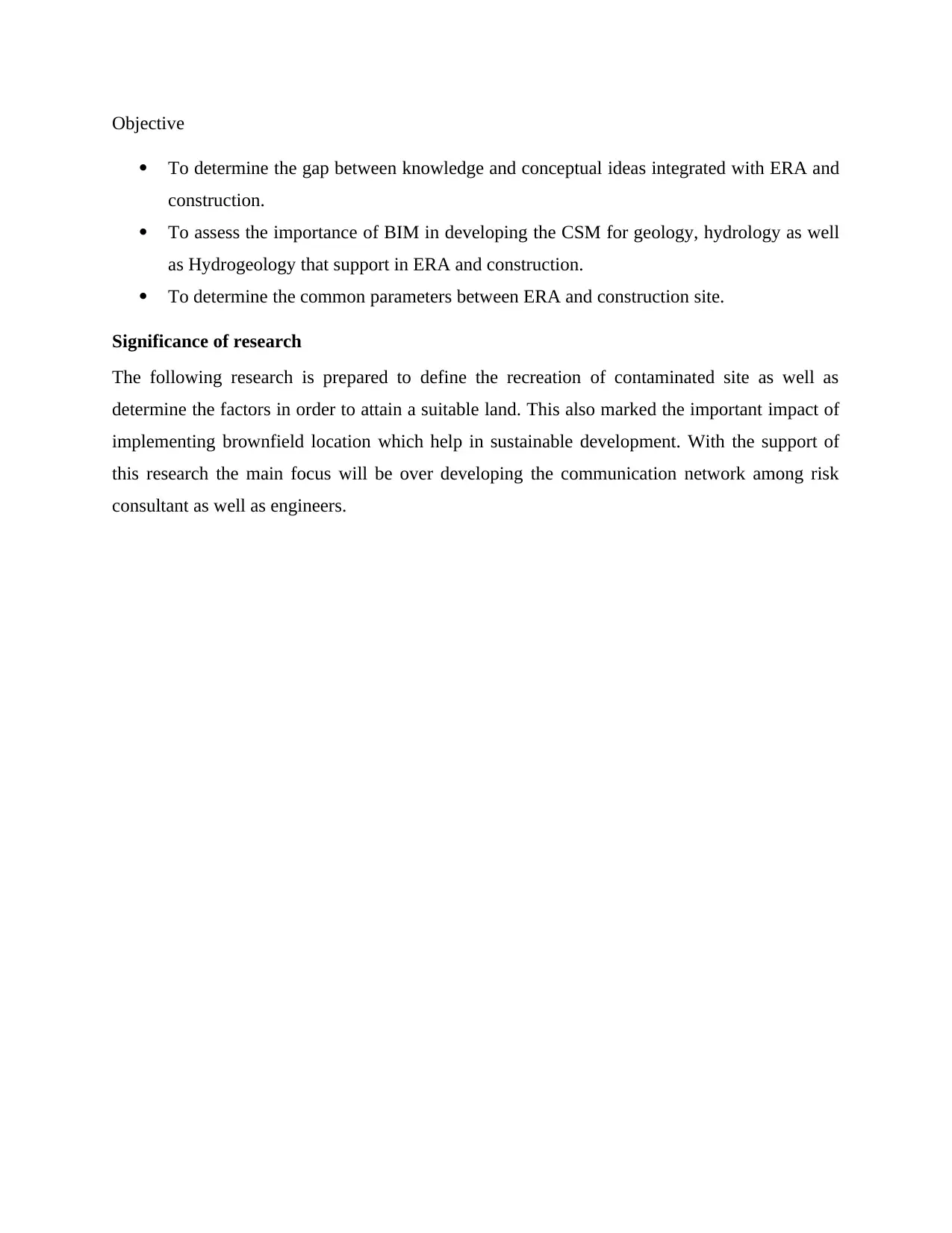
Objective
To determine the gap between knowledge and conceptual ideas integrated with ERA and
construction.
To assess the importance of BIM in developing the CSM for geology, hydrology as well
as Hydrogeology that support in ERA and construction.
To determine the common parameters between ERA and construction site.
Significance of research
The following research is prepared to define the recreation of contaminated site as well as
determine the factors in order to attain a suitable land. This also marked the important impact of
implementing brownfield location which help in sustainable development. With the support of
this research the main focus will be over developing the communication network among risk
consultant as well as engineers.
To determine the gap between knowledge and conceptual ideas integrated with ERA and
construction.
To assess the importance of BIM in developing the CSM for geology, hydrology as well
as Hydrogeology that support in ERA and construction.
To determine the common parameters between ERA and construction site.
Significance of research
The following research is prepared to define the recreation of contaminated site as well as
determine the factors in order to attain a suitable land. This also marked the important impact of
implementing brownfield location which help in sustainable development. With the support of
this research the main focus will be over developing the communication network among risk
consultant as well as engineers.
⊘ This is a preview!⊘
Do you want full access?
Subscribe today to unlock all pages.

Trusted by 1+ million students worldwide
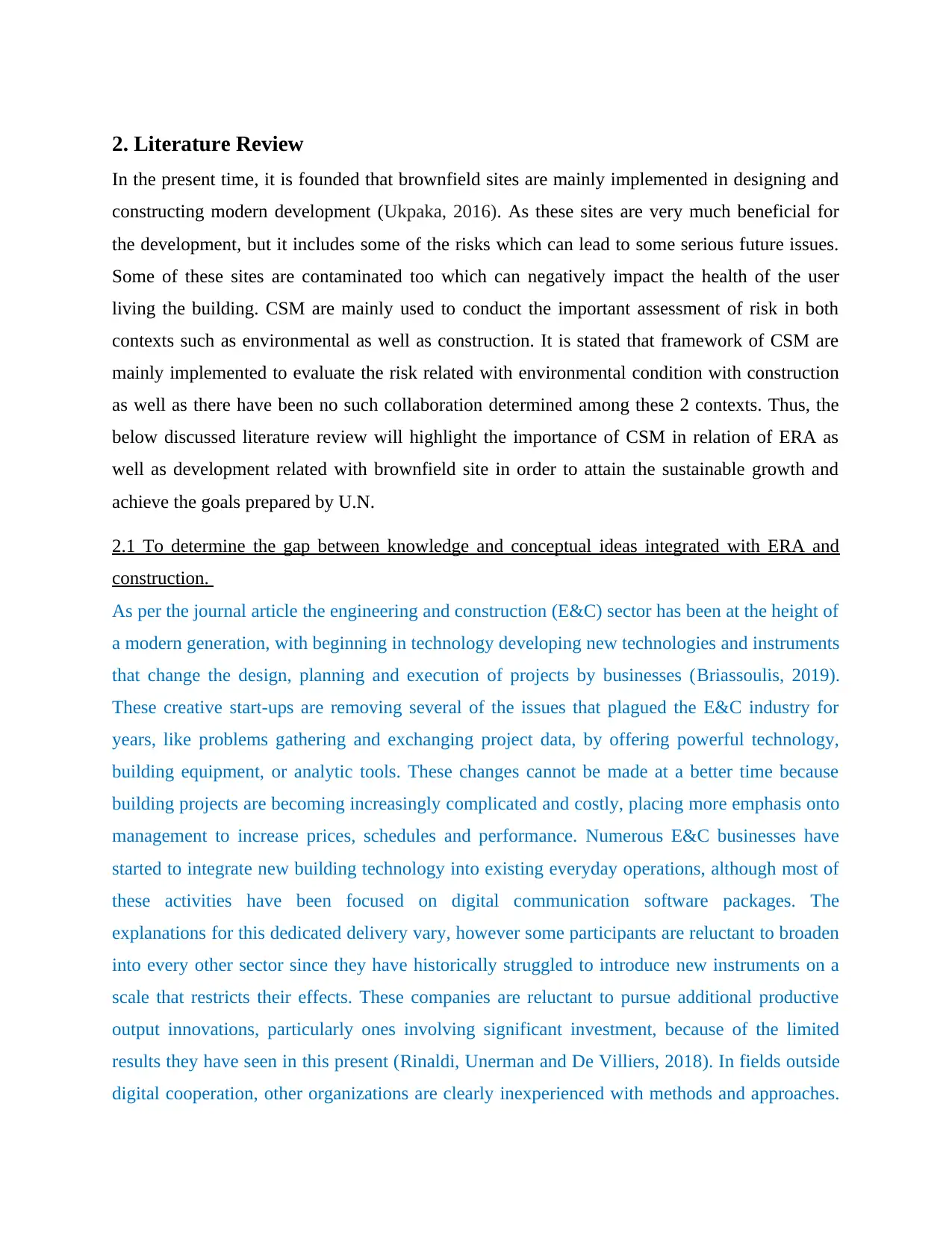
2. Literature Review
In the present time, it is founded that brownfield sites are mainly implemented in designing and
constructing modern development (Ukpaka, 2016). As these sites are very much beneficial for
the development, but it includes some of the risks which can lead to some serious future issues.
Some of these sites are contaminated too which can negatively impact the health of the user
living the building. CSM are mainly used to conduct the important assessment of risk in both
contexts such as environmental as well as construction. It is stated that framework of CSM are
mainly implemented to evaluate the risk related with environmental condition with construction
as well as there have been no such collaboration determined among these 2 contexts. Thus, the
below discussed literature review will highlight the importance of CSM in relation of ERA as
well as development related with brownfield site in order to attain the sustainable growth and
achieve the goals prepared by U.N.
2.1 To determine the gap between knowledge and conceptual ideas integrated with ERA and
construction.
As per the journal article the engineering and construction (E&C) sector has been at the height of
a modern generation, with beginning in technology developing new technologies and instruments
that change the design, planning and execution of projects by businesses (Briassoulis, 2019).
These creative start-ups are removing several of the issues that plagued the E&C industry for
years, like problems gathering and exchanging project data, by offering powerful technology,
building equipment, or analytic tools. These changes cannot be made at a better time because
building projects are becoming increasingly complicated and costly, placing more emphasis onto
management to increase prices, schedules and performance. Numerous E&C businesses have
started to integrate new building technology into existing everyday operations, although most of
these activities have been focused on digital communication software packages. The
explanations for this dedicated delivery vary, however some participants are reluctant to broaden
into every other sector since they have historically struggled to introduce new instruments on a
scale that restricts their effects. These companies are reluctant to pursue additional productive
output innovations, particularly ones involving significant investment, because of the limited
results they have seen in this present (Rinaldi, Unerman and De Villiers, 2018). In fields outside
digital cooperation, other organizations are clearly inexperienced with methods and approaches.
In the present time, it is founded that brownfield sites are mainly implemented in designing and
constructing modern development (Ukpaka, 2016). As these sites are very much beneficial for
the development, but it includes some of the risks which can lead to some serious future issues.
Some of these sites are contaminated too which can negatively impact the health of the user
living the building. CSM are mainly used to conduct the important assessment of risk in both
contexts such as environmental as well as construction. It is stated that framework of CSM are
mainly implemented to evaluate the risk related with environmental condition with construction
as well as there have been no such collaboration determined among these 2 contexts. Thus, the
below discussed literature review will highlight the importance of CSM in relation of ERA as
well as development related with brownfield site in order to attain the sustainable growth and
achieve the goals prepared by U.N.
2.1 To determine the gap between knowledge and conceptual ideas integrated with ERA and
construction.
As per the journal article the engineering and construction (E&C) sector has been at the height of
a modern generation, with beginning in technology developing new technologies and instruments
that change the design, planning and execution of projects by businesses (Briassoulis, 2019).
These creative start-ups are removing several of the issues that plagued the E&C industry for
years, like problems gathering and exchanging project data, by offering powerful technology,
building equipment, or analytic tools. These changes cannot be made at a better time because
building projects are becoming increasingly complicated and costly, placing more emphasis onto
management to increase prices, schedules and performance. Numerous E&C businesses have
started to integrate new building technology into existing everyday operations, although most of
these activities have been focused on digital communication software packages. The
explanations for this dedicated delivery vary, however some participants are reluctant to broaden
into every other sector since they have historically struggled to introduce new instruments on a
scale that restricts their effects. These companies are reluctant to pursue additional productive
output innovations, particularly ones involving significant investment, because of the limited
results they have seen in this present (Rinaldi, Unerman and De Villiers, 2018). In fields outside
digital cooperation, other organizations are clearly inexperienced with methods and approaches.
Paraphrase This Document
Need a fresh take? Get an instant paraphrase of this document with our AI Paraphraser
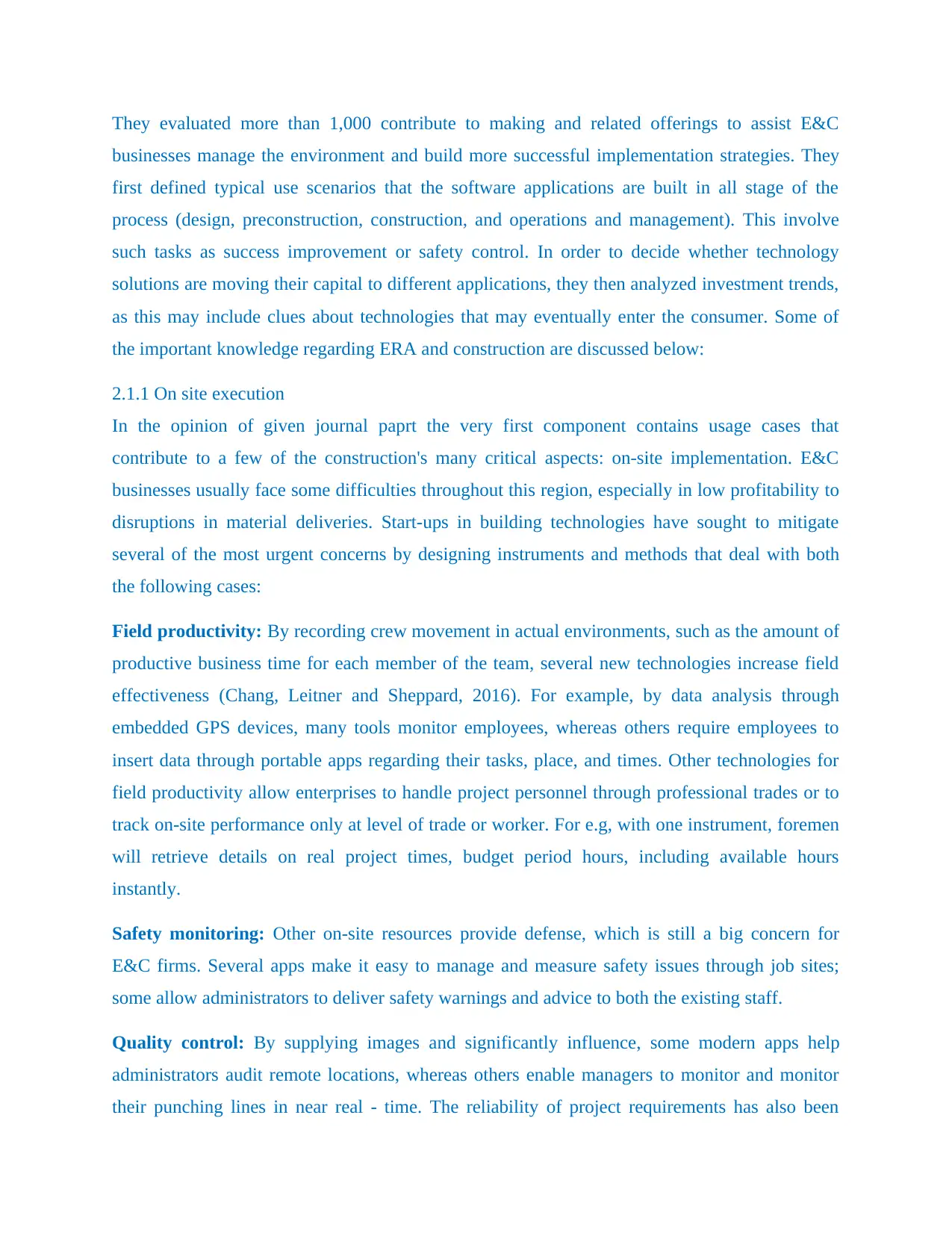
They evaluated more than 1,000 contribute to making and related offerings to assist E&C
businesses manage the environment and build more successful implementation strategies. They
first defined typical use scenarios that the software applications are built in all stage of the
process (design, preconstruction, construction, and operations and management). This involve
such tasks as success improvement or safety control. In order to decide whether technology
solutions are moving their capital to different applications, they then analyzed investment trends,
as this may include clues about technologies that may eventually enter the consumer. Some of
the important knowledge regarding ERA and construction are discussed below:
2.1.1 On site execution
In the opinion of given journal paprt the very first component contains usage cases that
contribute to a few of the construction's many critical aspects: on-site implementation. E&C
businesses usually face some difficulties throughout this region, especially in low profitability to
disruptions in material deliveries. Start-ups in building technologies have sought to mitigate
several of the most urgent concerns by designing instruments and methods that deal with both
the following cases:
Field productivity: By recording crew movement in actual environments, such as the amount of
productive business time for each member of the team, several new technologies increase field
effectiveness (Chang, Leitner and Sheppard, 2016). For example, by data analysis through
embedded GPS devices, many tools monitor employees, whereas others require employees to
insert data through portable apps regarding their tasks, place, and times. Other technologies for
field productivity allow enterprises to handle project personnel through professional trades or to
track on-site performance only at level of trade or worker. For e.g, with one instrument, foremen
will retrieve details on real project times, budget period hours, including available hours
instantly.
Safety monitoring: Other on-site resources provide defense, which is still a big concern for
E&C firms. Several apps make it easy to manage and measure safety issues through job sites;
some allow administrators to deliver safety warnings and advice to both the existing staff.
Quality control: By supplying images and significantly influence, some modern apps help
administrators audit remote locations, whereas others enable managers to monitor and monitor
their punching lines in near real - time. The reliability of project requirements has also been
businesses manage the environment and build more successful implementation strategies. They
first defined typical use scenarios that the software applications are built in all stage of the
process (design, preconstruction, construction, and operations and management). This involve
such tasks as success improvement or safety control. In order to decide whether technology
solutions are moving their capital to different applications, they then analyzed investment trends,
as this may include clues about technologies that may eventually enter the consumer. Some of
the important knowledge regarding ERA and construction are discussed below:
2.1.1 On site execution
In the opinion of given journal paprt the very first component contains usage cases that
contribute to a few of the construction's many critical aspects: on-site implementation. E&C
businesses usually face some difficulties throughout this region, especially in low profitability to
disruptions in material deliveries. Start-ups in building technologies have sought to mitigate
several of the most urgent concerns by designing instruments and methods that deal with both
the following cases:
Field productivity: By recording crew movement in actual environments, such as the amount of
productive business time for each member of the team, several new technologies increase field
effectiveness (Chang, Leitner and Sheppard, 2016). For example, by data analysis through
embedded GPS devices, many tools monitor employees, whereas others require employees to
insert data through portable apps regarding their tasks, place, and times. Other technologies for
field productivity allow enterprises to handle project personnel through professional trades or to
track on-site performance only at level of trade or worker. For e.g, with one instrument, foremen
will retrieve details on real project times, budget period hours, including available hours
instantly.
Safety monitoring: Other on-site resources provide defense, which is still a big concern for
E&C firms. Several apps make it easy to manage and measure safety issues through job sites;
some allow administrators to deliver safety warnings and advice to both the existing staff.
Quality control: By supplying images and significantly influence, some modern apps help
administrators audit remote locations, whereas others enable managers to monitor and monitor
their punching lines in near real - time. The reliability of project requirements has also been
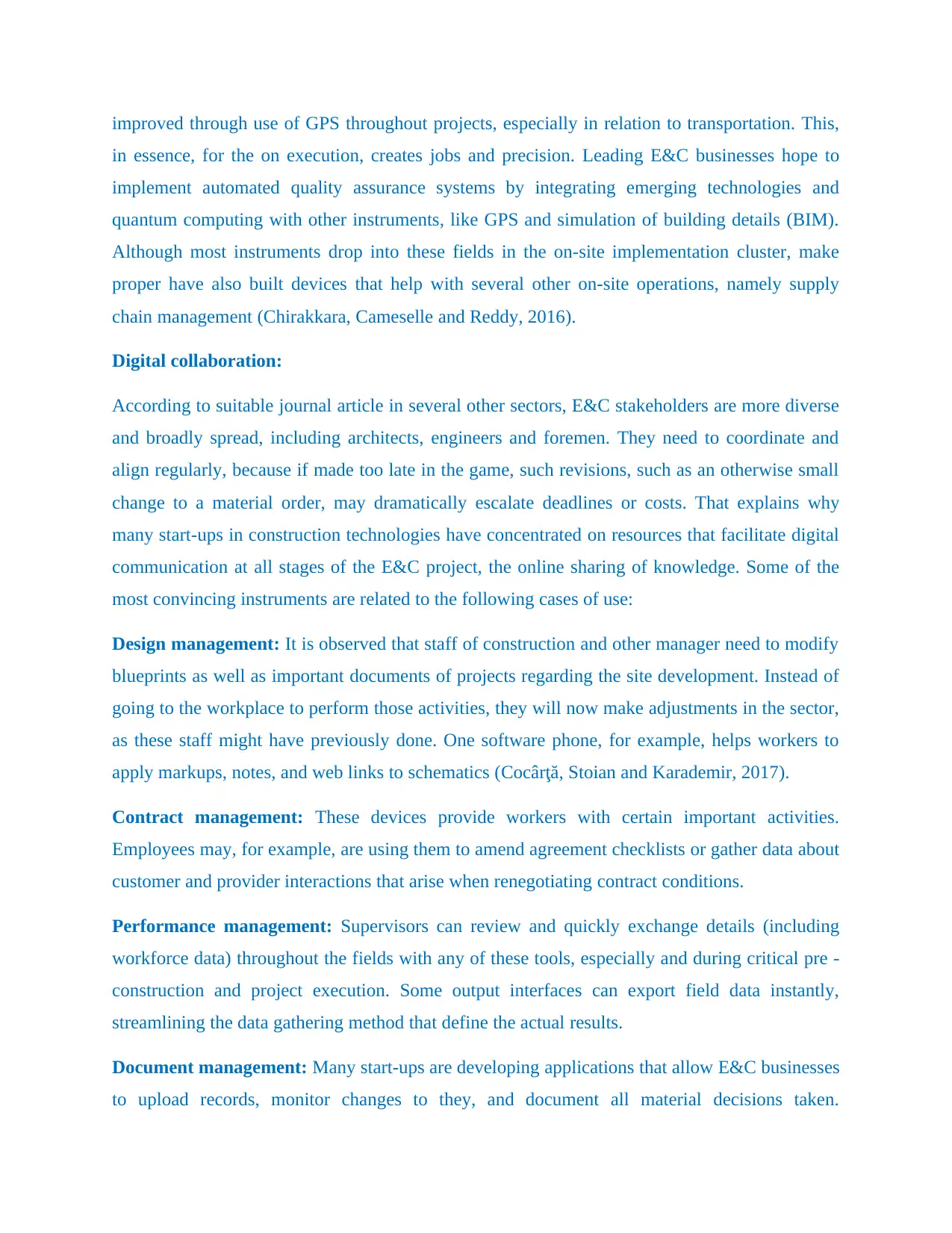
improved through use of GPS throughout projects, especially in relation to transportation. This,
in essence, for the on execution, creates jobs and precision. Leading E&C businesses hope to
implement automated quality assurance systems by integrating emerging technologies and
quantum computing with other instruments, like GPS and simulation of building details (BIM).
Although most instruments drop into these fields in the on-site implementation cluster, make
proper have also built devices that help with several other on-site operations, namely supply
chain management (Chirakkara, Cameselle and Reddy, 2016).
Digital collaboration:
According to suitable journal article in several other sectors, E&C stakeholders are more diverse
and broadly spread, including architects, engineers and foremen. They need to coordinate and
align regularly, because if made too late in the game, such revisions, such as an otherwise small
change to a material order, may dramatically escalate deadlines or costs. That explains why
many start-ups in construction technologies have concentrated on resources that facilitate digital
communication at all stages of the E&C project, the online sharing of knowledge. Some of the
most convincing instruments are related to the following cases of use:
Design management: It is observed that staff of construction and other manager need to modify
blueprints as well as important documents of projects regarding the site development. Instead of
going to the workplace to perform those activities, they will now make adjustments in the sector,
as these staff might have previously done. One software phone, for example, helps workers to
apply markups, notes, and web links to schematics (Cocârţă, Stoian and Karademir, 2017).
Contract management: These devices provide workers with certain important activities.
Employees may, for example, are using them to amend agreement checklists or gather data about
customer and provider interactions that arise when renegotiating contract conditions.
Performance management: Supervisors can review and quickly exchange details (including
workforce data) throughout the fields with any of these tools, especially and during critical pre -
construction and project execution. Some output interfaces can export field data instantly,
streamlining the data gathering method that define the actual results.
Document management: Many start-ups are developing applications that allow E&C businesses
to upload records, monitor changes to they, and document all material decisions taken.
in essence, for the on execution, creates jobs and precision. Leading E&C businesses hope to
implement automated quality assurance systems by integrating emerging technologies and
quantum computing with other instruments, like GPS and simulation of building details (BIM).
Although most instruments drop into these fields in the on-site implementation cluster, make
proper have also built devices that help with several other on-site operations, namely supply
chain management (Chirakkara, Cameselle and Reddy, 2016).
Digital collaboration:
According to suitable journal article in several other sectors, E&C stakeholders are more diverse
and broadly spread, including architects, engineers and foremen. They need to coordinate and
align regularly, because if made too late in the game, such revisions, such as an otherwise small
change to a material order, may dramatically escalate deadlines or costs. That explains why
many start-ups in construction technologies have concentrated on resources that facilitate digital
communication at all stages of the E&C project, the online sharing of knowledge. Some of the
most convincing instruments are related to the following cases of use:
Design management: It is observed that staff of construction and other manager need to modify
blueprints as well as important documents of projects regarding the site development. Instead of
going to the workplace to perform those activities, they will now make adjustments in the sector,
as these staff might have previously done. One software phone, for example, helps workers to
apply markups, notes, and web links to schematics (Cocârţă, Stoian and Karademir, 2017).
Contract management: These devices provide workers with certain important activities.
Employees may, for example, are using them to amend agreement checklists or gather data about
customer and provider interactions that arise when renegotiating contract conditions.
Performance management: Supervisors can review and quickly exchange details (including
workforce data) throughout the fields with any of these tools, especially and during critical pre -
construction and project execution. Some output interfaces can export field data instantly,
streamlining the data gathering method that define the actual results.
Document management: Many start-ups are developing applications that allow E&C businesses
to upload records, monitor changes to they, and document all material decisions taken.
⊘ This is a preview!⊘
Do you want full access?
Subscribe today to unlock all pages.

Trusted by 1+ million students worldwide
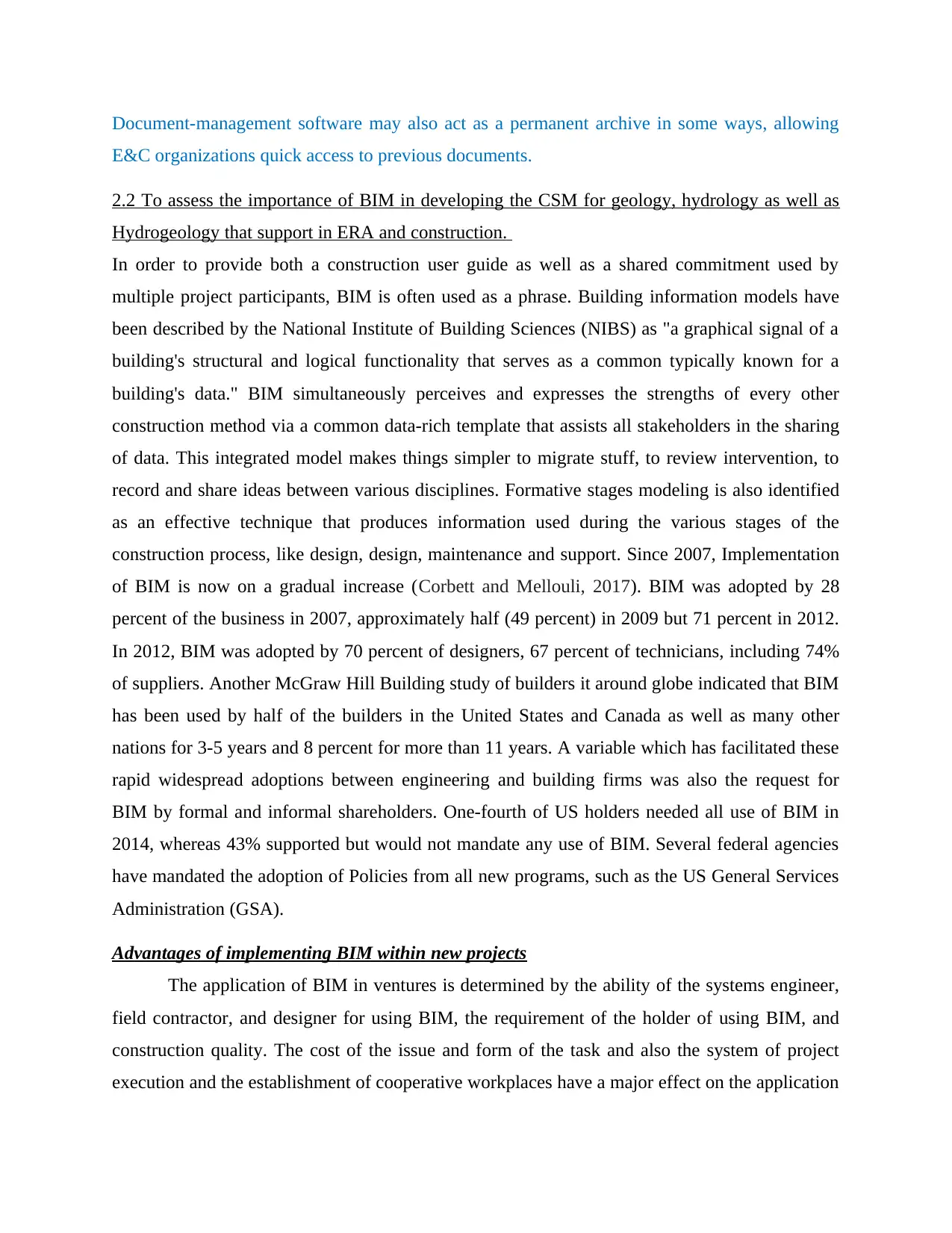
Document-management software may also act as a permanent archive in some ways, allowing
E&C organizations quick access to previous documents.
2.2 To assess the importance of BIM in developing the CSM for geology, hydrology as well as
Hydrogeology that support in ERA and construction.
In order to provide both a construction user guide as well as a shared commitment used by
multiple project participants, BIM is often used as a phrase. Building information models have
been described by the National Institute of Building Sciences (NIBS) as "a graphical signal of a
building's structural and logical functionality that serves as a common typically known for a
building's data." BIM simultaneously perceives and expresses the strengths of every other
construction method via a common data-rich template that assists all stakeholders in the sharing
of data. This integrated model makes things simpler to migrate stuff, to review intervention, to
record and share ideas between various disciplines. Formative stages modeling is also identified
as an effective technique that produces information used during the various stages of the
construction process, like design, design, maintenance and support. Since 2007, Implementation
of BIM is now on a gradual increase (Corbett and Mellouli, 2017). BIM was adopted by 28
percent of the business in 2007, approximately half (49 percent) in 2009 but 71 percent in 2012.
In 2012, BIM was adopted by 70 percent of designers, 67 percent of technicians, including 74%
of suppliers. Another McGraw Hill Building study of builders it around globe indicated that BIM
has been used by half of the builders in the United States and Canada as well as many other
nations for 3-5 years and 8 percent for more than 11 years. A variable which has facilitated these
rapid widespread adoptions between engineering and building firms was also the request for
BIM by formal and informal shareholders. One-fourth of US holders needed all use of BIM in
2014, whereas 43% supported but would not mandate any use of BIM. Several federal agencies
have mandated the adoption of Policies from all new programs, such as the US General Services
Administration (GSA).
Advantages of implementing BIM within new projects
The application of BIM in ventures is determined by the ability of the systems engineer,
field contractor, and designer for using BIM, the requirement of the holder of using BIM, and
construction quality. The cost of the issue and form of the task and also the system of project
execution and the establishment of cooperative workplaces have a major effect on the application
E&C organizations quick access to previous documents.
2.2 To assess the importance of BIM in developing the CSM for geology, hydrology as well as
Hydrogeology that support in ERA and construction.
In order to provide both a construction user guide as well as a shared commitment used by
multiple project participants, BIM is often used as a phrase. Building information models have
been described by the National Institute of Building Sciences (NIBS) as "a graphical signal of a
building's structural and logical functionality that serves as a common typically known for a
building's data." BIM simultaneously perceives and expresses the strengths of every other
construction method via a common data-rich template that assists all stakeholders in the sharing
of data. This integrated model makes things simpler to migrate stuff, to review intervention, to
record and share ideas between various disciplines. Formative stages modeling is also identified
as an effective technique that produces information used during the various stages of the
construction process, like design, design, maintenance and support. Since 2007, Implementation
of BIM is now on a gradual increase (Corbett and Mellouli, 2017). BIM was adopted by 28
percent of the business in 2007, approximately half (49 percent) in 2009 but 71 percent in 2012.
In 2012, BIM was adopted by 70 percent of designers, 67 percent of technicians, including 74%
of suppliers. Another McGraw Hill Building study of builders it around globe indicated that BIM
has been used by half of the builders in the United States and Canada as well as many other
nations for 3-5 years and 8 percent for more than 11 years. A variable which has facilitated these
rapid widespread adoptions between engineering and building firms was also the request for
BIM by formal and informal shareholders. One-fourth of US holders needed all use of BIM in
2014, whereas 43% supported but would not mandate any use of BIM. Several federal agencies
have mandated the adoption of Policies from all new programs, such as the US General Services
Administration (GSA).
Advantages of implementing BIM within new projects
The application of BIM in ventures is determined by the ability of the systems engineer,
field contractor, and designer for using BIM, the requirement of the holder of using BIM, and
construction quality. The cost of the issue and form of the task and also the system of project
execution and the establishment of cooperative workplaces have a major effect on the application
Paraphrase This Document
Need a fresh take? Get an instant paraphrase of this document with our AI Paraphraser
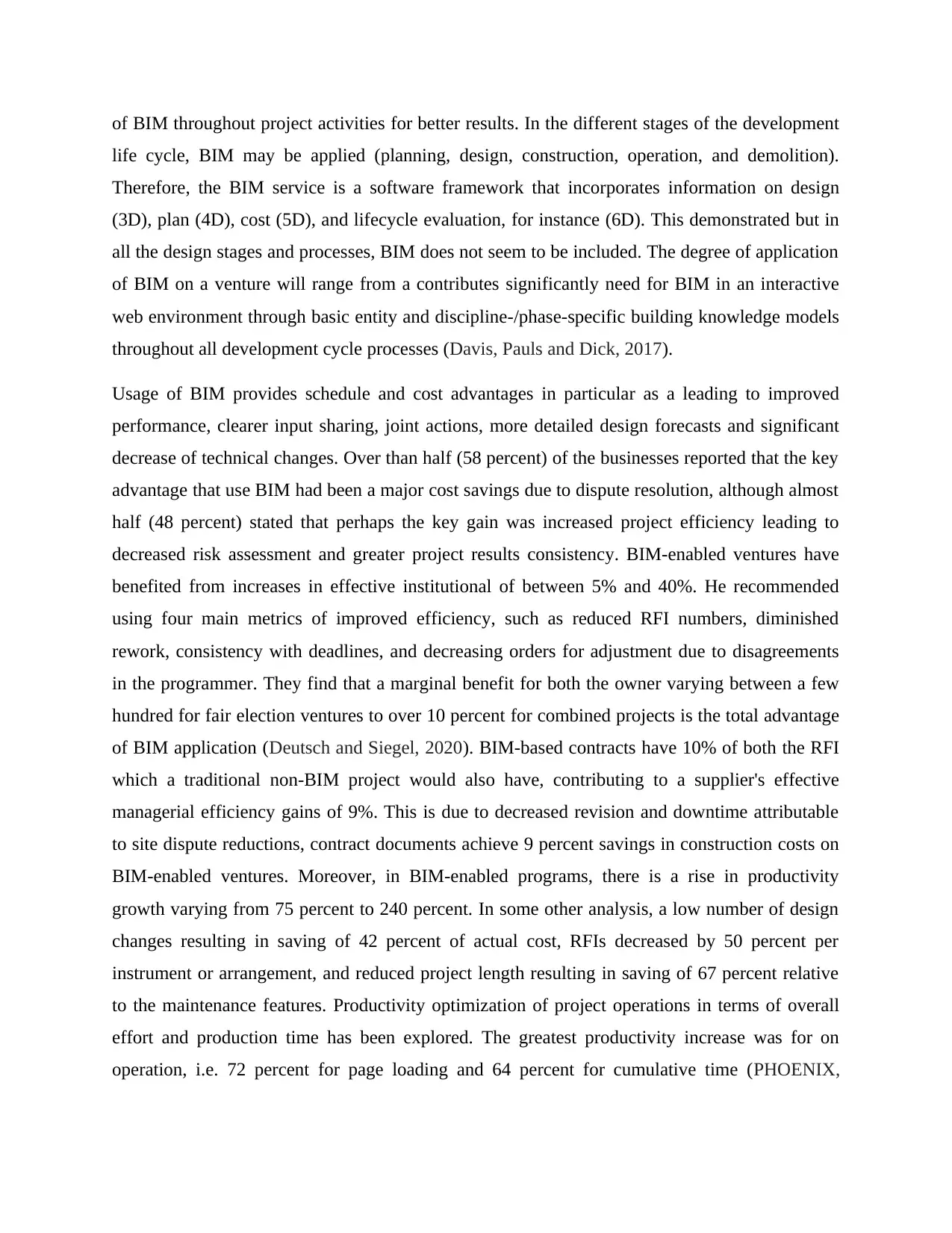
of BIM throughout project activities for better results. In the different stages of the development
life cycle, BIM may be applied (planning, design, construction, operation, and demolition).
Therefore, the BIM service is a software framework that incorporates information on design
(3D), plan (4D), cost (5D), and lifecycle evaluation, for instance (6D). This demonstrated but in
all the design stages and processes, BIM does not seem to be included. The degree of application
of BIM on a venture will range from a contributes significantly need for BIM in an interactive
web environment through basic entity and discipline-/phase-specific building knowledge models
throughout all development cycle processes (Davis, Pauls and Dick, 2017).
Usage of BIM provides schedule and cost advantages in particular as a leading to improved
performance, clearer input sharing, joint actions, more detailed design forecasts and significant
decrease of technical changes. Over than half (58 percent) of the businesses reported that the key
advantage that use BIM had been a major cost savings due to dispute resolution, although almost
half (48 percent) stated that perhaps the key gain was increased project efficiency leading to
decreased risk assessment and greater project results consistency. BIM-enabled ventures have
benefited from increases in effective institutional of between 5% and 40%. He recommended
using four main metrics of improved efficiency, such as reduced RFI numbers, diminished
rework, consistency with deadlines, and decreasing orders for adjustment due to disagreements
in the programmer. They find that a marginal benefit for both the owner varying between a few
hundred for fair election ventures to over 10 percent for combined projects is the total advantage
of BIM application (Deutsch and Siegel, 2020). BIM-based contracts have 10% of both the RFI
which a traditional non-BIM project would also have, contributing to a supplier's effective
managerial efficiency gains of 9%. This is due to decreased revision and downtime attributable
to site dispute reductions, contract documents achieve 9 percent savings in construction costs on
BIM-enabled ventures. Moreover, in BIM-enabled programs, there is a rise in productivity
growth varying from 75 percent to 240 percent. In some other analysis, a low number of design
changes resulting in saving of 42 percent of actual cost, RFIs decreased by 50 percent per
instrument or arrangement, and reduced project length resulting in saving of 67 percent relative
to the maintenance features. Productivity optimization of project operations in terms of overall
effort and production time has been explored. The greatest productivity increase was for on
operation, i.e. 72 percent for page loading and 64 percent for cumulative time (PHOENIX,
life cycle, BIM may be applied (planning, design, construction, operation, and demolition).
Therefore, the BIM service is a software framework that incorporates information on design
(3D), plan (4D), cost (5D), and lifecycle evaluation, for instance (6D). This demonstrated but in
all the design stages and processes, BIM does not seem to be included. The degree of application
of BIM on a venture will range from a contributes significantly need for BIM in an interactive
web environment through basic entity and discipline-/phase-specific building knowledge models
throughout all development cycle processes (Davis, Pauls and Dick, 2017).
Usage of BIM provides schedule and cost advantages in particular as a leading to improved
performance, clearer input sharing, joint actions, more detailed design forecasts and significant
decrease of technical changes. Over than half (58 percent) of the businesses reported that the key
advantage that use BIM had been a major cost savings due to dispute resolution, although almost
half (48 percent) stated that perhaps the key gain was increased project efficiency leading to
decreased risk assessment and greater project results consistency. BIM-enabled ventures have
benefited from increases in effective institutional of between 5% and 40%. He recommended
using four main metrics of improved efficiency, such as reduced RFI numbers, diminished
rework, consistency with deadlines, and decreasing orders for adjustment due to disagreements
in the programmer. They find that a marginal benefit for both the owner varying between a few
hundred for fair election ventures to over 10 percent for combined projects is the total advantage
of BIM application (Deutsch and Siegel, 2020). BIM-based contracts have 10% of both the RFI
which a traditional non-BIM project would also have, contributing to a supplier's effective
managerial efficiency gains of 9%. This is due to decreased revision and downtime attributable
to site dispute reductions, contract documents achieve 9 percent savings in construction costs on
BIM-enabled ventures. Moreover, in BIM-enabled programs, there is a rise in productivity
growth varying from 75 percent to 240 percent. In some other analysis, a low number of design
changes resulting in saving of 42 percent of actual cost, RFIs decreased by 50 percent per
instrument or arrangement, and reduced project length resulting in saving of 67 percent relative
to the maintenance features. Productivity optimization of project operations in terms of overall
effort and production time has been explored. The greatest productivity increase was for on
operation, i.e. 72 percent for page loading and 64 percent for cumulative time (PHOENIX,
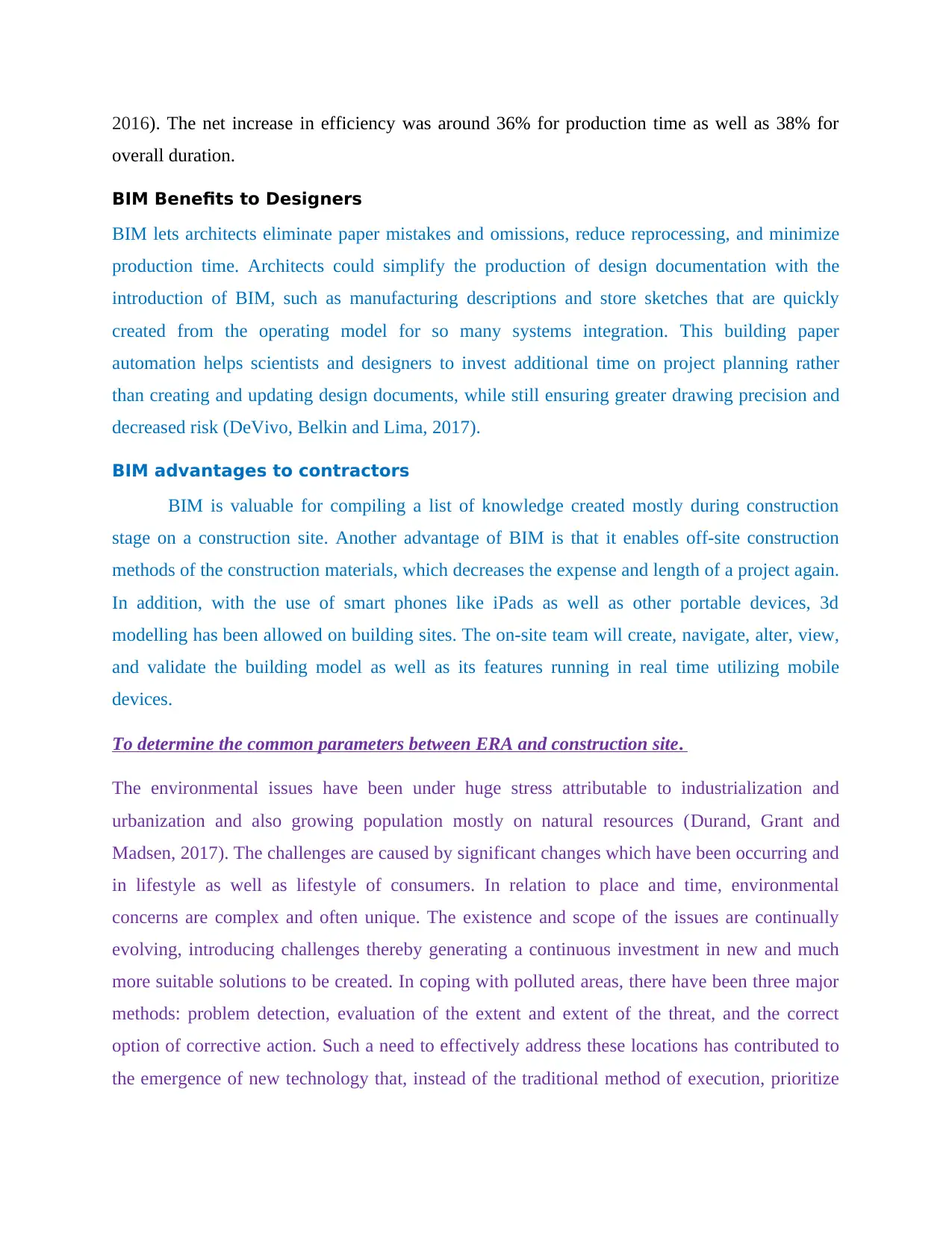
2016). The net increase in efficiency was around 36% for production time as well as 38% for
overall duration.
BIM Benefits to Designers
BIM lets architects eliminate paper mistakes and omissions, reduce reprocessing, and minimize
production time. Architects could simplify the production of design documentation with the
introduction of BIM, such as manufacturing descriptions and store sketches that are quickly
created from the operating model for so many systems integration. This building paper
automation helps scientists and designers to invest additional time on project planning rather
than creating and updating design documents, while still ensuring greater drawing precision and
decreased risk (DeVivo, Belkin and Lima, 2017).
BIM advantages to contractors
BIM is valuable for compiling a list of knowledge created mostly during construction
stage on a construction site. Another advantage of BIM is that it enables off-site construction
methods of the construction materials, which decreases the expense and length of a project again.
In addition, with the use of smart phones like iPads as well as other portable devices, 3d
modelling has been allowed on building sites. The on-site team will create, navigate, alter, view,
and validate the building model as well as its features running in real time utilizing mobile
devices.
To determine the common parameters between ERA and construction site.
The environmental issues have been under huge stress attributable to industrialization and
urbanization and also growing population mostly on natural resources (Durand, Grant and
Madsen, 2017). The challenges are caused by significant changes which have been occurring and
in lifestyle as well as lifestyle of consumers. In relation to place and time, environmental
concerns are complex and often unique. The existence and scope of the issues are continually
evolving, introducing challenges thereby generating a continuous investment in new and much
more suitable solutions to be created. In coping with polluted areas, there have been three major
methods: problem detection, evaluation of the extent and extent of the threat, and the correct
option of corrective action. Such a need to effectively address these locations has contributed to
the emergence of new technology that, instead of the traditional method of execution, prioritize
overall duration.
BIM Benefits to Designers
BIM lets architects eliminate paper mistakes and omissions, reduce reprocessing, and minimize
production time. Architects could simplify the production of design documentation with the
introduction of BIM, such as manufacturing descriptions and store sketches that are quickly
created from the operating model for so many systems integration. This building paper
automation helps scientists and designers to invest additional time on project planning rather
than creating and updating design documents, while still ensuring greater drawing precision and
decreased risk (DeVivo, Belkin and Lima, 2017).
BIM advantages to contractors
BIM is valuable for compiling a list of knowledge created mostly during construction
stage on a construction site. Another advantage of BIM is that it enables off-site construction
methods of the construction materials, which decreases the expense and length of a project again.
In addition, with the use of smart phones like iPads as well as other portable devices, 3d
modelling has been allowed on building sites. The on-site team will create, navigate, alter, view,
and validate the building model as well as its features running in real time utilizing mobile
devices.
To determine the common parameters between ERA and construction site.
The environmental issues have been under huge stress attributable to industrialization and
urbanization and also growing population mostly on natural resources (Durand, Grant and
Madsen, 2017). The challenges are caused by significant changes which have been occurring and
in lifestyle as well as lifestyle of consumers. In relation to place and time, environmental
concerns are complex and often unique. The existence and scope of the issues are continually
evolving, introducing challenges thereby generating a continuous investment in new and much
more suitable solutions to be created. In coping with polluted areas, there have been three major
methods: problem detection, evaluation of the extent and extent of the threat, and the correct
option of corrective action. Such a need to effectively address these locations has contributed to
the emergence of new technology that, instead of the traditional method of execution, prioritize
⊘ This is a preview!⊘
Do you want full access?
Subscribe today to unlock all pages.

Trusted by 1+ million students worldwide
1 out of 19
Your All-in-One AI-Powered Toolkit for Academic Success.
+13062052269
info@desklib.com
Available 24*7 on WhatsApp / Email
![[object Object]](/_next/static/media/star-bottom.7253800d.svg)
Unlock your academic potential
Copyright © 2020–2025 A2Z Services. All Rights Reserved. Developed and managed by ZUCOL.
